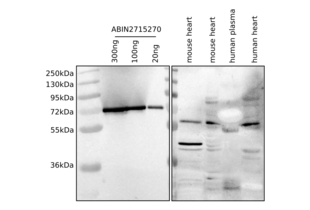BIN1 Protein (Transcript Variant 8) (Myc-DYKDDDDK Tag)
-
- Target See all BIN1 Proteins
- BIN1 (Bridging Integrator 1 (BIN1))
- Protein Type
- Recombinant
- Protein Characteristics
- Transcript Variant 8
-
Origin
- Human
-
Source
- HEK-293 Cells
- Purification tag / Conjugate
- This BIN1 protein is labelled with Myc-DYKDDDDK Tag.
- Application
- Antibody Production (AbP), Standard (STD)
- Characteristics
-
- Recombinant human BIN1 / AMPHL (transcript variant 8) protein expressed in HEK293 cells.
- Produced with end-sequenced ORF clone
- Purity
- > 80 % as determined by SDS-PAGE and Coomassie blue staining
-
-
- Application Notes
-
Recombinant human proteins can be used for:
Native antigens for optimized antibody production
Positive controls in ELISA and other antibody assays - Comment
-
The tag is located at the C-terminal.
- Restrictions
- For Research Use only
-
- by
- Department of Medical Physiology, UMC Utrecht
- No.
- #102757
- Date
- 05/03/2018
- Antigen
- BIN1
- Lot Number
- 10C425
- Method validated
- Western Blotting
- Positive Control
- BIN1 antibody, endogenous BIN1 in mouse heart lysates and human plasma and heart lysate
- Negative Control
- none
- Notes
Passed. The recombinant BIN1 protein ABIN2715270 works excellently in western blot and appears at the expected MW.
- Primary Antibody
- rabbit anti-BIN1 antibody (Sigma-Aldrich, HPA003894, lot R04603)
- Secondary Antibody
- goat anti-rabbit HRP-conjugated antibody (Bio-Rad Cat, 170-6515)
- Full Protocol
- Lyse half a murine heart or a corresponding piece (in size) of human heart tissue in 250µl of lysis buffer (20mM Tris-HCl pH7.4, 150mM NaCl, 10mM Na2HPO4, 1% Triton X-100, 1% Na-deoxycholate, 0.1% SDS, 1mM EDTA, 50mM NaF).
- Determine total protein content of the lysates and human plasma samples using Pierce BCA Protein Assay Kit (ThermoFisher Scientific, 23227, lot SC246925).
- Sample preparation:
- Dilute appropriate amount of lysate in lysis buffer + 5x Laemmli SDS sample buffer (lysis buffer:sample buffer 4:1) to achieve 25µg of protein per 20µl of sample, boil the samples for 5min at 96°C.
- Dilute appropriate amount of human plasma in lysis buffer + 5x Laemmli SDS sample buffer (lysis buffer:sample buffer 4:1) to achieve 25µg of protein per 20µl of sample, boil the samples for 5min at 96°C.
- 20ng, 100ng, and 300ng recombinant BIN1 (antibodies-online, ABIN2715270, lot 10C425) were diluted in 20µl ddH2O + 5x Laemmli SDS sample buffer (ddH2O:sample buffer 4:1), samples were boiled for5min at 96°C.
- Separate the samples on a freshly cast discontinuous denaturing SDS-PAGE 10% running gel in an electrophoresis chamber (Bio-Rad) for approximately 20min at 75-100V for the stacking and 1h at 100-200V for the running gel.
- Transfer proteins onto a nitrocellulose membrane 0.45µm (Bio-Rad, 1620115, lot A10206645) with a Hoefer TE 77 semi-dry transfer unit (Amersham Biosciences) for 70min at 43mA/gel.
- Verify protein transfer through Ponceau Red staining.
- Block the membrane with blocking buffer (TBST containing 5% BSA) for 1h at RT.
- Incubation with primary rabbit anti-BIN1 antibody (Sigma-Aldrich, HPA003894, lot R04603) diluted 1:500 in blocking buffer for ON at 4°C.
- Wash membrane 3x for 10min with TBST.
- Incubation with secondary goat anti-rabbit HRP-conjugated antibody (Bio-Rad Cat, 170-6515) diluted 1:7000 in blocking buffer for 1-2h at RT.
- Wash membrane 3x for 10min with TBST.
- Reveal protein bands using ECL substrate (GE Healthcare, RPN2232, lot 13601176) on an ChemiDoc XRS + (BioRad) and ImageLab (version 6.0.0 build 25, standard edition. 2017, BioRad laboratories, Inc) software was used to determine best exposure time for optimal visualization of bands.
- Experimental Notes
The BIN1 antibody reveals a protein of the expected MW. ABIN2715270 migrates higher than the endogenous murine and human proteins due to the C-terminal myc- and DYKDDDDK-tags.
Validation #102757 (Western Blotting)![Successfully validated 'Independent Validation' Badge]()
![Successfully validated 'Independent Validation' Badge]() Validation ImagesFull Methods
Validation ImagesFull Methods -
- Concentration
- 50 μg/mL
- Buffer
- 25 mM Tris.HCl, pH 7.3, 100 mM glycine, 10 % glycerol.
- Storage
- -80 °C
- Storage Comment
- Store at -80°C. Thaw on ice, aliquot to individual single-use tubes, and then re-freeze immediately. Only 2-3 freeze thaw cycles are recommended.
-
- Target
- BIN1 (Bridging Integrator 1 (BIN1))
- Alternative Name
- Bin1,amphl (BIN1 Products)
- Synonyms
- bin1 Protein, MGC53185 Protein, amph2 Protein, amphl Protein, sh3p9 Protein, MGC76187 Protein, cb57 Protein, zgc:86701 Protein, BIN1 Protein, AMPH2 Protein, AMPHL Protein, SH3P9 Protein, ALP-1 Protein, Amphl Protein, BRAMP-2 Protein, bridging integrator 1 Protein, bridging integrator 1 S homeolog Protein, bridging integrator 1b Protein, BIN1 Protein, bin1.S Protein, bin1 Protein, bin1b Protein, Bin1 Protein
- Background
- This gene encodes several isoforms of a nucleocytoplasmic adaptor protein, one of which was initially identified as a MYC-interacting protein with features of a tumor suppressor. Isoforms that are expressed in the central nervous system may be involved in synaptic vesicle endocytosis and may interact with dynamin, synaptojanin, endophilin, and clathrin. Isoforms that are expressed in muscle and ubiquitously expressed isoforms localize to the cytoplasm and nucleus and activate a caspase-independent apoptotic process. Studies in mouse suggest that this gene plays an important role in cardiac muscle development. Alternate splicing of the gene results in several transcript variants encoding different isoforms. Aberrant splice variants expressed in tumor cell lines have also been described.
- Molecular Weight
- 50 kDa
- NCBI Accession
- NP_004296
-


 (1 validation)
(1 validation)



